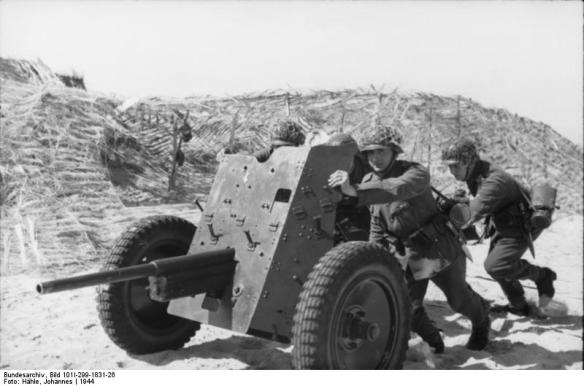The original 3.7-cm Pak 35/36 produced during the late 1920s had spoked wheels for horse traction, but by the mid-1930s these had been replaced by steel disc wheels for motor traction. It was a light and low gun that was at first issued to all arms of the Wehrmacht.
In 1943, the introduction of the Stielgranate 41 shaped charge meant that the Pak 36 could now penetrate any armour, although the low velocity of the projectile limited its range. The Pak 36s, together with the new shaped charges, were issued to Fallschirmjäger units and other light troops. The gun’s low weight meant that it could be easily moved by hand, and this mobility made it ideal for their purpose.
The rapid development and proliferation of tanks during the interwar years and during World War II necessitated weapons to counter their threat. Germany introduced special antitank artillery and armor-piercing rounds during the latter half of World War I, and by World War II all major powers fielded similar weapons. Such ordnance required powerful armor-piercing capabilities to defeat ever-improving armor, yet also had to be concealable. To address these twin problems, some engineers turned to extremely high velocity projectiles or other types of unique design.
Following Hitler’s assumption of power in 1933, Germany began an intensive antitank gun development program that continued through the war years. Adopted in 1936, the 37mm PaK36 was the primary Nazi antitank gun until it was superseded in 1940 by the semiautomatic 50mm PaK38, which fired a 4.8-pound shell up to 2,898 yards. The still more powerful 75mm PaK40 and 75mm PaK97/38 were adopted in 1941. Germany also fielded numerous captured Allied weapons, such as the Soviet M30, designated the 76.2mm PaK36(r) in German service.
The origins of the gun that was to become the 3.7-cm Pak 35/36 (Pak for Panzerabwehrkanone, or anti-tank gun) can be traced back to 1925 when Rheinmetall began actively to design and develop an anti-tank gun for the German army. Production began in 1928, and as the German army was at that time still largely horse-oriented the gun was fitted with spoked wheels for horse traction. It was a very modern gun design for the period and used a well-sloped shield, tubular split-trail legs and a long slender barrel. At first production was relatively limited, but once the NSDAP came to power in 1933 production was greatly accelerated. In 1934 there appeared the first version with steel wheels and pneumatic tyres suitable for vehicle traction, and the designation 3.7-cm Pak 35/36 was assigned in 1936.
It was in 1936 that the Pak 35/36 first saw action, during the Spanish Civil War where the little gun proved eminently suited against the relatively light armoured vehicles used during the conflict. It also proved successful in 1939 against the lightly-armed Poles, but in 1940 the Pak gun crews encountered the more heavily armoured French and British tanks and had the unfortunate experience of seeing their carefully-aimed armour-piercing projectiles bouncing off the hulls of attacking tanks. The truth was that by 1940 the Pak 35/36 had had its day. It was no longer powerful enough to penetrate the armour of the more modern tanks, and larger calibre weapons had to take its place, But these latter could not be produced quickly enough to prevent the 37-mm (1.46-in) guns from having to be rushed to action during the German invasion of the Soviet Union (Operation ‘Barbarossa’) in 1941; against the T-34/76 tank they again proved to be of no use at all.
In 1943, the introduction of the Stielgranate 41 shaped charge meant that the Pak 36 could now penetrate any armour, although the low velocity of the projectile limited its range. The Pak 36s, together with the new shaped charges, were issued to Fallschirmjäger units and other light troops. The gun’s low weight meant that it could be easily moved by hand, and this mobility made it ideal for their purpose. Consequently the Pak 35/36 was passed to second-line and garrison units, and to some training schools, so the type was still in limited service in 1945. Many carriages were later converted to take 75-mm (2.95-in) barrels to convert them to infantry support guns.
The Pak 35/36 was widely exported before 1939, and the design was copied in Japan as the Type 97. Other recipient nations were Italy (Cannone contracarro da 37/45), the Netherlands (37-mm Rheinmetall) and the Soviet Union, where the Pak 35/36 was known as the M30, was widely copied and formed the basis for a whole family of 37-mm (1.46-in) and 45-mm (1.77-in) anti-tank guns that served on for many years after 1945 (some were still in service in Soviet-influenced nations as late as the 1970s). The design was also copied in the United States to produce the Antitank Gun M3, although only the concept was copied as the M3 had many detail differences from the German original.
At one point the Germans produced a special version of the Pak 35/36 for paradropping.
Specification 3.7-cm Pak 35/36 Calibre: 37 mm (1.46 in) Length of gun: 1,665 m (5 ft 5.5 in) Length of rifling: 1.308 m (4 ft. 5in) Weight: travelling 440 kg (970 lb) and in action 328 kg (723 lb) Traverse: 59° Elevation: -8° to +25° Muzzle velocity: AP 760 m (2,495 ft) per second Maximum range: 7000 m (7,655 yards) Projectile weight: AP 0.354 kg (0.78 lb) or HE 0.625 kg (1.38 lb) Armour penetration: 38 mm ( 1.48 in) at 30° at 365 m (400 yards)
